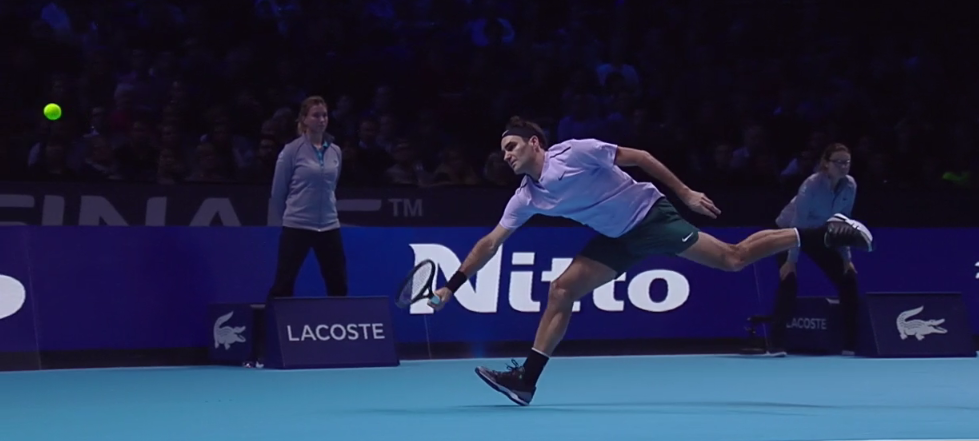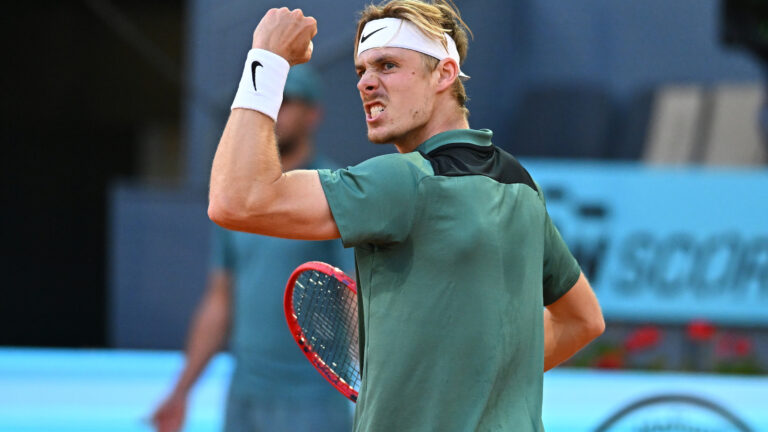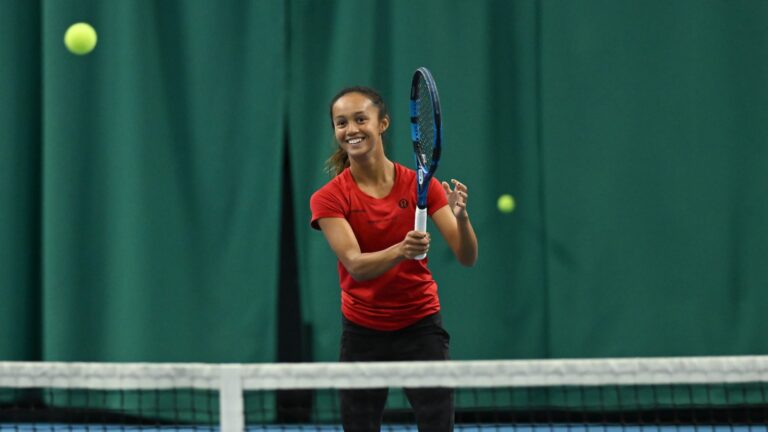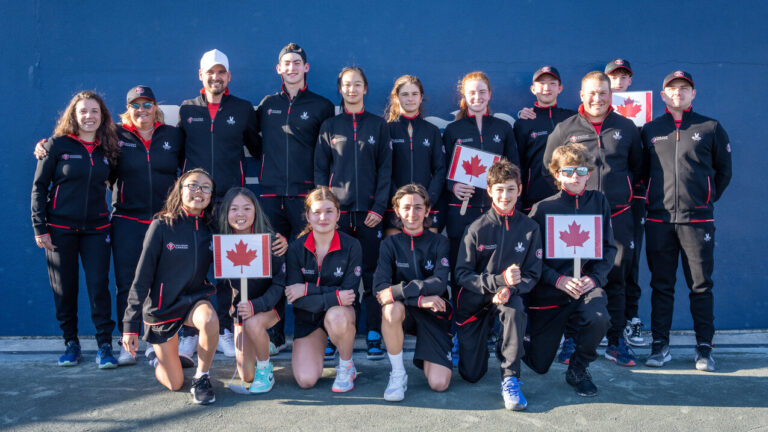
It’s the time of year when even the most ardent tennis followers find themselves occasionally thinking, “when is this all going to end?”
Many people, including the players, are jaded and longing for the six or seven week break before the new season begins.
That break is just long enough for fans to really miss the sport and be fired up for the new season and its big early payoff at the Australian Open.
There’s still good tennis being played and that was on display Monday as David Goffin defeated World No. 1 Rafael Nadal 7-6(5), 6-7(4), 6-4 in an opening round-robin match at the ATP Finals in London. It was a dramatic encounter and Nadal played phenomenally on three of the four set points he saved in the second set to send the match into a deciding third.
He was obviously not at his best – his movement was somewhat compromised and the knee problem he has been struggling with is obviously still an issue.
The news that he has pulled out of the event is sad but probably good for his fans who want to see him at his physical best for the 2018 season.

He deserves credit for making the effort in London and was present Sunday at the O2 Arena to pick up his World No. 1 trophy. ‘Rafa’ has now been the year-end No. 1 four times – 2008, 2010, 2013 and this year. At 31, he’s the oldest player to finish in the year-end top spot since computer rankings were introduced in 1973.
Roger Federer has been the season-ending No. 1 five times – 2004-2007 and 2009. Fed fans will regret that he didn’t somehow make it six in 2017 because that would have made him the oldest and, at age 36, by a significant margin. That’s a mark that could easily have stood for many years (decades?) to come.
The ATP Finals in London are always staged in a first-class manner so hopefully there will be more drama right up until the final is played at 6 p.m. on Sunday in London. It will be carried in Canada on TSN2 at 1 p.m. ET.

The women’s year came to its conclusion (except for a $125,000 WTA Challenger in Taipei this week) last Sunday when the USA defeated Belarus 3-2 in the Fed Cup final in Minsk. It was an 18th Fed Cup title for the Americans, but their first since 2000.
Team competitions like Fed Cup and Davis Cup often produce unlikely heroes and heroines and the underdog Belorussians pushed the Americans to the hilt – a fifth and deciding (doubles) match. Belarus, with Victoria Azarenka at home in California with her young son, was led by No. 78 Aryna Sabalenka, 19, and 23-year-old Aliaksandra Sasnovich, No. 87. The Americans featured No. 10 Coco Vandeweghe and No. 13 Sloane Stephens, the US Open champion.
Stephens fought hard but extended her post-US Open losing streak to six matches She was beaten 6-3, 3-6, 6-4 by the imposing Sabalenka and 4-6, 6-1, 8-6 by the scrappy Sasnovich.
Vandeweghne was the story of the final, winning both her singles in straight sets and combining with Shelby Rogers in the decisive doubles for a 6-3, 7-6(3) victory over Sabalenka and Sasnovich – rallying from a 2-5 deficit in the second set.
Starting the year with a semi-final at the Australian Open, Vandeweghe finished it with a flourish – becoming the first player since the current format was introduced in 2005 to win eight (six singles and two doubles) Fed Cup matches in one year.
It also ended the longest American victory drought – 17 years since 2000 – in the in the history of an event that dates back to 1963.
The Canadian Fed Cup team resumes play February 10-11, 2018, when it travels to Cluj-Napoca for an opening-round World Group II match-up against Romania.
THE NEXT-GEN INNOVATIONS

The Next Gen ATP Finals took place in Milan last week – here’s a look at all the changes that were tried and how they turned out.
SCORING: All matches were best-of-five sets with the sets made up of just four games, with a 12-point tiebreak played at 3-all.
COMMENT: We were rooting for this one but it just doesn’t work. If a player holds serve in the first game, breaks in the second and then holds again in the third, it’s 3-0 and feels like the set is over in about 10 minutes. Let’s face it – this ain’t ever coming in at the Grand Slam level. So using it at lower-tier events would just end up being confusing.
One thing about the three-out-of-five, there would be more end-of-set breaks that would make the concessions people happy – except if spectators stayed away too long they might miss a whole set!
NO-AD SCORING: Already used in doubles on the ATP tour, it was the first player to win four points who wins the game. There was no ‘deuce-advantage.’
COMMENT: This is something that it would be easy to get used to. But deuce/ad is so ingrained in the sport that it would be difficult to change. Still – this isn’t a deal-breaker.

NO LETS: There were no ‘let’ serves – if a serve landed in after touching the net, the receiver had to play it.
COMMENT: Didn’t get to see enough of them to form a definite opinion – but certainly tilting toward no lets and being able to get rid of the annoying arguments about whether the ball actually touched the net or not.
NO LINES-PERSONS: All line calls were made by the electronic line-calling Hawk-Eye system with no lines-persons on court – and everything overseen by an umpire.
COMMENT: The court definitely looked cleaner without lines-persons on it – and sponsors must have been happy because their exposure was more uncluttered and prominent.
The voices that called “out” (ATP umpire Ali Nili) and “fault” (a female friend of Nili’s) worked okay but maybe a greater variety next time might make things more natural and less ‘Big Brother-ish.’
One gets the sense that a classic match-up like Federer vs. Nadal might be even more dramatic with them isolated on a court with no lines people.
The negatives are that the current ‘challenge system’ on line calls adds an interesting dimension that would be lost. And, the cost of having Hawk-Eye on every court would have to be weighed against the cost of having lines-persons.
START TIME: From the time the second player got to his courtside chair after the walkout, the players had five minutes to finish the warm-up and start the first point.
COMMENT : A personal preference here would be to limit the time from when a player gets to the courtside chair to when he has to be out for the coin toss to 30 – 60 seconds maximum. Then maybe have just a three or four-minute warm-up instead of five.
SPECTATOR MOVEMENT: Members of the Next Gen crowd in Milan were free to come and go at anytime during the match except for those seated behind the court.
COMMENT: This didn’t really seem to come into play – partly because there were so few seats on the ends and anyway there didn’t seem to be much movement on the sides. But things could be much different in an outdoor stadium.
As mentioned last week – movement should be allowed 20 rows up on the ends and 10 rows up on the sides. Players would get accustomed to that.

COACHING: Coaching (Fernando Vicente with Andrey Rublev above) during the Next Gen Finals was only allowed via headsets at the end of sets. The coaches did not come onto the court.
COMMENT: This seemed to work well except for the fact that players had to speak English, which was obviously unfair to some players and coaches. The audio of the voices came through well on TV and there was no distraction element involved. But the basic question remains – should coaching of any kind be allowed?
COURTSIDE TIME-CLOCK: There were clocks in the corner of the court and on the scoreboard to count down the 25 seconds allowed between points.
COMMENT: We still worry about a contentious/chaotic situation in a match with a partisan crowd counting down out loud when an opposing player is slow serving. But the countdown clock definitely seemed to work well in Milan.
ONLY ONE MEDICAL TIME-OUT: The players were only allowed one medical time-out (MTO) during a match.
COMMENT: It didn’t seem to be a big issue but we still worry that more players, because of limiting MTOs, might have to retire during matches. The paying public, and television, wouldn’t be too pleased about that.
ONLY A SINGLES COURT: All the matches at Next Gen were played on a singles court without doubles lines.
COMMENT: This looked great. It seemed like on television, without the doubles alleys, it was easier to follow the players during side-to-side points. But singles courts are impractical if doubles is involved in the event – unless someday there’s a technology that’s capable of removing the doubles lines and then automatically putting them back in place.
REWARDS FOR ZHAO, PELIWO
🏆 First 100K title 🏆
It’s been a long way here since January and I owe this to the small group of people whose belief in me never wavered even when mine did. There are still many, many more miles to go but I’m so so grateful for you, and for this. 🙏🤘🌲 pic.twitter.com/RnuaQnCQAt
— Carol Zhao 一羽 (@CarolZhao95) November 12, 2017
Two of the hardest-working, most tenacious players in Canadian tennis were rewarded for their efforts over the weekend – Carol Zhao won a $100,000 Challenger event in Shenzhen, China, while Filip Peliwo took the title at the $75,000 Knoxville Challenger in Tennessee.
Zhao, 22, headed for Shenzhen after a second round loss while not feeling well at the Tevlin Challenger in Toronto. It turned out to be an inspired week for her as she defeated No. 156-ranked Fangzhou Liu of China 7-5, 6-2 in the final.
Her toughest test came in round two when she overcame Laura Robson of Great Britain 6-1, 4-6, 7-5.
The first Challenger title of her career boosts Zhao’s ranking 71 points – from No. 221 to No. 150 and makes her the No. 3 ranked Canadian behind Genie Bouchard at No. 83 and No. 125 Françoise Abanda.
First Challenger title!! 🏆 https://t.co/kiB1Dbolab
— Filip Peliwo (@filippeliwo) November 13, 2017
Peliwo travelled a longer road to his first Challenger victory in Knoxville – he won a grand total of eight matches. That included three in the qualifying, with his final round coming 6-2, 6-2 over fellow Canadian Samuel Monette.
In the main draw, Peliwo defeated two highly-touted 20-year-old American prospects – No. 157 Tommy Paul 6-4, 7-5 in the first round and No. 110 Taylor Fritz 7-6(7), 6-1 in the quarter-finals. In the final, Peliwo outplayed No. 177 Denis Kudla of the U.S. 6-4, 6-2.
The win gives the 23-year-old Peliwo a new career high (from No. 223) at No. 195. He’s now the sixth-ranked Canadian behind Milos Raonic (24), Denis Shapovalov (51), Vasek Pospisil (109), Peter Polansky (138), and Félix Auger- Aliassime (159).
Both Zhao and Peliwo have assured themselves of spots in the 2018 Australian Open qualifying with their successes.
HALE & HURRICANE HELP
Toronto Rogers Cup tournament director Karl Hale has been doing what he can to assist with relief efforts after the recent devastating hurricanes in the Caribbean.
On Sunday in St. Johns, Antigua, he organized an exhibition between between world No. 29 Philipp Kohlschreiber and No. 196, Brayden Schnur for the Antigua and Barbuda Cup.
The German veteran was the winner in two tiebreak sets over Schnur in a match played at the Antigua National Tennis Center. There were 400 spectators present and $5,000 was raised for Barbuda Charities.
Earlier, Hale had helped stage an exhibition between Darian King of Barbados and Jesse Witten of the U.S. in Bridgetown, Barbados. That match was played before 600 spectators and raised $4,000 for “Tennis Helps the Caribbean.”
MILOS AND YOUR MONEY
No one has ever questioned Milos Raonic’s smarts – here he shows them off as he gives a concise lecture on interest rates and how they can affect your pocket cash.
How do interest rates work? Tennis star Milos Raonic takes a swing at explaining. pic.twitter.com/fuo1KbBNfu
— Maclean's Magazine (@macleans) October 24, 2017
NOVAK IS MR. CLUTCH ON TV
Right-handed, lefthanded – Novak Djokovic gets it done either way on The Late Late Show with James Corden. Must-see video below:
Almost hit @jkcorden’s head! 😬 Here’s me doing 🎾 target practice on the #latelateshow https://t.co/vAPKeJNDK7
— Novak Djokovic (@DjokerNole) November 10, 2017
Feature Picture: TennisTV.com



